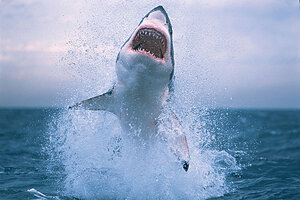Shark attacks worldwide: bites are up, fatalities down
Worldwide, the number of shark attacks has grown each decade, hitting 646 in the 2000s. That's because so many more people are beachgoers. But fatalities from shark bites are quickly dropping.

Reported shark attacks are up workdwide this decade as a result of increased numbers of people in the water. Fatalities from those attacks, however, have declined as a result of better and closer medical aid.
Photo courtesy Seapics.Com via Discovery Channel/Newscom
Next time you visit the beach, bear in mind that shark attacks are up virtually everywhere in the world – mainly a result of the fact that so many more people are frolicking on sharks' home, uh, turf. On the bright side: If bitten, you’re much less likely to die as a result.
Worldwide, the number of shark attacks has been growing by leaps each decade, according to a University of Florida study released Monday. But as attacks have steadily climbed during the past century, fatalities are quickly dropping.
Researchers recorded some 646 shark attacks in the past decade, up from 493 attacks in the 1990s.
IN PICTURES: Top shark attack locations
The increase in attacks since 2000 has more to do with human population and behavior than with sharks, says George Burgess, director of the International Shark Attack File at the University of Florida, a group that tracks shark attacks around the world. (See the group's map of shark attacks here.)
“Frankly, we’re swamping the waters with humans relative to sharks,” says Mr. Burgess. “It says more about human patterns and behavior than shark patterns.”
Shark attacks are dictated by the number of people and sharks sharing the same space, says Burgess. As world populations rise and people spend more hours in the ocean, attacks are bound to rise. (The Monitor puts the likelihood of a shark attack into perspective here.)
The study highlights another important trend: Fatalities from attacks are dropping. About 61 percent of attacks were fatal a century ago, at the start of the 1900s. Today, fatalities per attack are at about 7 percent.
“That’s a huge change, reflective of the advances we’ve made,” says Burgess “We’ve got better medical response, emergency care personnel are closer to sea now, lifeguards are on beaches. And we like to think our advice is beginning to have an effect on people making good choices about where they go and when.” (Read here about shark attack survivors who want the US to strengthen shark-protection laws.)
The US and Australia lead the world in shark attacks. In 2009, the study recorded 61 attacks worldwide, up slightly from 2008. With 28 incidents, the US had the most shark attacks last year. Australia followed with 20. South Africa had six attacks. (To meet South Africa's top shark spotter, click here.)
But attacks have been down in the US during the past three years, dropping from 50 in 2007, to 41 in 2008, to 28 in 2009. Burgess says the down economy may be one explanation for the atypical downward trend.
“To get people in the water, you’ve got to get people to beaches,” he says. “In harder economic times, not as much money is allowed for holidays to the beach, so one wonders whether the economy is a factor.”
The study reported five shark attack fatalities in 2009, four of which were in South Africa’s white shark-rich waters, and all of which involved people who were boarding: bodysurfing, paddle boarding, or surfing.
“Surfers are the No. 1 target group involved in shark attacks worldwide,” says Burgess. “Their activities – splashing and kicking of feet – are provocative to sharks, who react especially well to movement or splashing at the water’s surface.”
Surfers are also more vulnerable because they tend to be in areas with good wave action, where there’s a concentration of sharks. And, says Burgess, surfing is a solitary sport, leaving people farther offshore and away from help, if trouble arises.
The best advice, he says, is to remember the ocean is a wild environment, not an expansive swimming pool.
“Every time we enter the sea, it’s a wilderness experience,” says Burgess. “We need to remember that and accept a certain amount of risk going to sea, much as we do going hiking in the Rockies or wandering through the Serengeti in Africa.”
